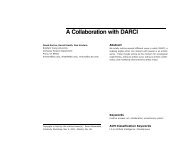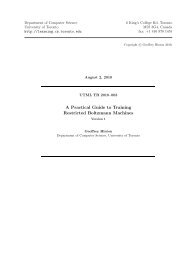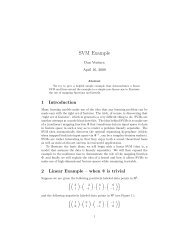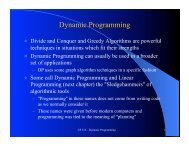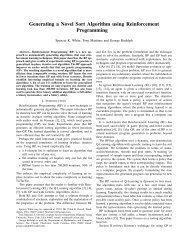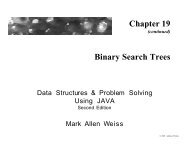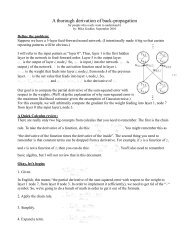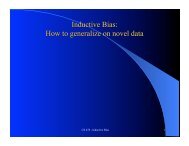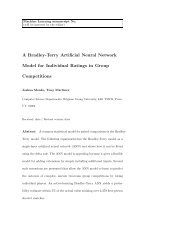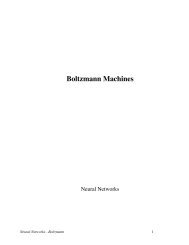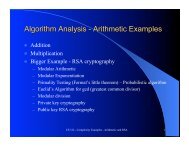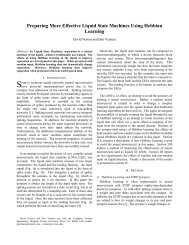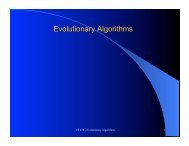Toward Optimal Active Learning through Sampling ... - CiteSeerX
Toward Optimal Active Learning through Sampling ... - CiteSeerX
Toward Optimal Active Learning through Sampling ... - CiteSeerX
Create successful ePaper yourself
Turn your PDF publications into a flip-book with our unique Google optimized e-Paper software.
data set of 2000 documents was split into a training set of<br />
1000 documents, and 1000 test documents.<br />
We tested 4 different active learning algorithms:<br />
Random – choosing the query document at random.<br />
0.9<br />
0.85<br />
0.8<br />
Accuracy on comp.graphics vs. comp.windows.x<br />
Uncertainty <strong>Sampling</strong> – choosing the document with the<br />
largest label uncertainty, as in (Lewis & Gale, 1994).<br />
Density-Weighted QBC – choosing the document with<br />
the greatest committee disagreement in the predicted<br />
label, as measured by Jensen-Shannon divergence,<br />
weighted by document density, as in (McCallum &<br />
Nigam, 1998b). The number of committees used is three.<br />
Error-Reduction <strong>Sampling</strong> – the method introduced in<br />
this paper – choosing the document that maximizes the<br />
reduction in the total predicted label entropy, as in equation<br />
(1), with error as given in equation (3). 2 The number<br />
of bags used is three.<br />
The algorithms were initially given 6 labeled examples, 3<br />
from each class.<br />
At each iteration, 250 documents (25% of the unlabeled<br />
documents) were randomly sampled from the larger pool<br />
of unlabeled documents as candidates for labeling. 3 The<br />
error metric was then computed for each putative labeling<br />
against all remaining unlabeled documents (not just the<br />
sampled pool.) Figure 1 shows the active learning process.<br />
The vertical axis show classification accuracy on the heldout<br />
test set, up to 100 queries. All results reported are the<br />
average of 10 trials.<br />
The solid gray line at 89.2% shows the maximum possible<br />
accuracy after all the unlabeled data has been labeled.<br />
After 16 queries, the Error-Reduction <strong>Sampling</strong> algorithm<br />
reached 77.2%, or 85% of the maximum possible accuracy.<br />
The Density-Weighted QBC took 68 queries to reach<br />
the same point (four times more slowly), and maintained a<br />
lower accuracy for the remainder of the queries.<br />
It is also interesting to compare the documents chosen by<br />
the two algorithms for initial labeling. Looking at the documents<br />
chosen in the first 10 queries, over the 10 trials,<br />
the first 10 documents chosen by the Error-Reduction <strong>Sampling</strong><br />
algorithm were an FAQ, tutorial or HOW-TO 9.8<br />
times out of ten. By comparison, the first 10 documents<br />
chosen by the Density-Weighted QBC algorithm were an<br />
FAQ or HOW-TO only 5.8 times out of 10. While the high<br />
incidence of the highly informative documents in the initial<br />
phases is not quantitatively meaningful, it does suggest that<br />
the learner’s behavior is somewhat intuitive.<br />
2 We also tried Error-Reduction <strong>Sampling</strong> with 0/1 loss, but<br />
performance was essentially random. As of yet, we have no explanation.<br />
3 The sub-sampling was performed in the interests of these experimental<br />
results. In a real active learning setting, all algorithms<br />
would be run over as much unlabeled data as was computationally<br />
feasible in that setting.<br />
Accuracy<br />
0.75<br />
0.7<br />
0.65<br />
0.6<br />
Error-Reduction <strong>Sampling</strong><br />
0.55<br />
Density-weighted QBC<br />
Uncertainty <strong>Sampling</strong><br />
Random<br />
0.5<br />
0 20 40 60 80 100<br />
Number of Added Labeled Examples<br />
Figure 1. Average test set accuracy for comp.graphics vs.<br />
comp.windows.x. The Error-Reduction <strong>Sampling</strong> algorithm<br />
reaches 85% of maximum in 16 documents, compared to 68 documents<br />
for the Most Disagreed algorithm. The error bars are placed<br />
at local maximum to reduce clutter.<br />
The particular newsgroups in the preceding experiment<br />
were chosen because they are relatively easy to distinguish.<br />
A more difficult text-categorization problem is classifying<br />
the newsgroups comp.sys.ibm.pc.hardware and<br />
comp.os.ms-windows.misc. The documents were<br />
pre-processed as before, resulting in a vocabulary size of<br />
9,895. The data set of 2000 documents was split into a<br />
training set of 1000 documents, and 1000 test documents.<br />
Also as before, the unlabeled data was sampled randomly<br />
down to 250 documents for candidate labelings at each iteration,<br />
although the sampling error was measured against<br />
all unlabeled documents.<br />
We can again examine the documents chosen by the different<br />
algorithms during the initial phases. Error-Reduction<br />
<strong>Sampling</strong> had an average incidence of 7.3 FAQs in the first<br />
10 documents, compared with 2.6 for Density-Weighted<br />
QBC. In this experiment, however, we see that the intuitive<br />
behavior is not sufficient for one algorithm to clearly<br />
out-perform another, and the learners required several more<br />
documents to begin to achieve a reasonable accuracy.<br />
The solid gray line at 88% shows the maximum possible<br />
accuracy after all the unlabeled data has been labeled.<br />
After 42 queries, the Error-Reduction <strong>Sampling</strong> algorithm<br />
reached 75%, or 85% of the maximum possible accuracy.<br />
The Density-Weighted QBC algorithm reached the same accuracy<br />
after 70 queries, or 1.6 times more slowly.<br />
JOB CATEGORY DOMAIN<br />
The third set of experiments used a data set collected at<br />
WhizBang! Labs. The Job Category data set contained<br />
112, 643 documents containing job descriptions for 16 different<br />
categories such as Clerical, Educational or<br />
Engineer. The 16 different categories were then bro-



